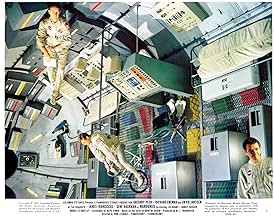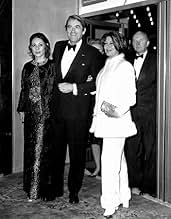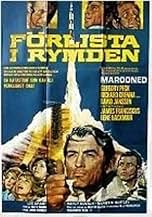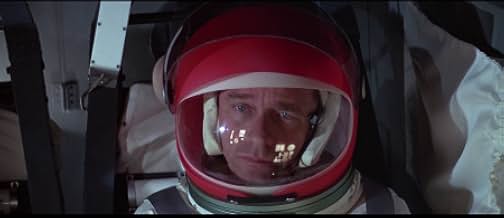Füge eine Handlung in deiner Sprache hinzuThree American astronauts are stranded in space when their retros won't fire. Can they be rescued before their oxygen runs out?Three American astronauts are stranded in space when their retros won't fire. Can they be rescued before their oxygen runs out?Three American astronauts are stranded in space when their retros won't fire. Can they be rescued before their oxygen runs out?
- Regie
- Drehbuch
- Hauptbesetzung
- 1 Oscar gewonnen
- 1 Gewinn & 3 Nominierungen insgesamt
Empfohlene Bewertungen
Sadly, 'bulk' is right when it comes to this movie: it's way overlong, with much of the length consisting of repetitive dialogue sequences or scenes which add little to the narrative. In some cases, it actually feels quite stodgy, especially during the lengthy mid section. I was often looking at the clock and wondering how much more of this I could sit through.
Invariably, the special effects are quite dated and often look laughable in this day and age. Yet despite these detractions, the film does have a special kind of timeliness to it (considering the year it was made) which adds significance to the production. And I'll admit that things do get quite thrilling in the last half hour, when we're treated to the kind of suspense that should have been present all the way through.
The actors are the main reason to tune in these days: it's hard to fault any of them, but I think Crenna gives the best performance of the lot as a compassionate family man. Hackman is almost unrecognisable in comparison to the later tough, mannered character actor he became, and as always Franciscus seems to me to be underrated. Peck is very good too, but then that's a given.
But something goes terribly wrong with the reentry rockets and the guys are stranded up there in space with about a 42 hour supply of oxygen. It's looking pretty grim because we're not sure that a rescue mission is feasible. Chief astronaut David Janssen and Gregory Peck lock horns on this issue at a staff meeting. Add to that a hurricane is developing in Caribbean that will be passing over Florida and Cape Kennedy.
But they try and Marooned is about that attempt. As a film it doesn't get too much into character development except during a sequence when the astronaut wives, Lee Grant, Nancy Kovack, and Mariette Hartley are brought in to boost morale all around. It does concentrate on the rescue mission and the special effects for which Marooned got an Academy Award in 1969.
I'm not a science buff by any means, but Marooned was projected several years into the future, the long missions that Crenna, Hackman, and Franciscus were on were years away. But Marooned seemed to get the future right.
It's a dated film now, but still exciting and suspenseful.
A descriptive film about space mission with 3 marooned astronauts which had the misfortune to go out on release at precisely the time when the astronauts of Apollo 13 were fighting with an exactly similar emergency . Faced with real-life competition , the movie failed at box office due to its overlong runtime , slow-moving and was undeservedly buried ; however , nowadays is better deemed than when it was released . The plot is plain and simple , bearing remarkable and striking resemblance to subsequent Apollo 13 (1995) by Ron Howard , as three brave astronauts : Richard Crenna , James Franciscus , Gene Hackman , stranded 205,000 miles from Earth in a crippled spacecraft when its retro-rockets misfire , as they fight a desperate battle to survive , unable to go back to Earth , meanwhile , at Mission Control, astronaut David Janssen , flight director Gregory Peck and a heroic ground crew race against time and the odds to bring them home. The picture packs tension , intrigue , chills and the suspense builds remorselessly to a neat conclusion . This is a story of sacrifice , averted tragedy , comradeship , heroism and describes a will of creativity and effort on the technicians who ran the early space missions . The wide-screen are first-rate , as well as the special effects that are the main thing this Sci-Fi picture has going for it . Several dollars' worth of Hollywood top-drawer cast is partially wasted in this flick of three astronauts unable to return to Earth .
The motion picture was professionally directed by John Sturges, though with no much enthusiasm , and including some moments amazingly inept ; however , winning Oscar for Special Effects , FX, that are really fabulous . Sturges began his directing career at Columbia Pictures, from there he moved on to MGM where he filmed more "B" pictures, albeit on a larger budget . He established an independent production company in 1959, releasing through United Artists. From 1960-67 he worked under contract for United Artists. His first major hit was the western Dog Day at Black Rock (1955) , which he shot in just three weeks, wrapping up virtually every scene in a single take . He specialized in robust action pictures, particularly westerns. He excelled at bringing to life tautly written stories about tough characters facing difficult circumstances . Throughout his career he regularly alternated hits with misses . He has also been criticized for his lack of stylistic trademarks , though his best films remain exciting to watch . Sturges was expert on all kind of genres , but especially warlike such as : ¨Great Escape¨, ¨Ice Station Zebra¨ and ¨Eagle has landed¨ and Western such as ¨Last train of Gun Hill¨, ¨Magnificent Seven¨, ¨Backlash¨, ¨Law and Jake Webb¨, ¨Joe Kidd¨ and Chino¨, among others . Rating : 6/10 . Passable and acceptable , but a little bit boring and tiring . Well worth seeing .
The film is a near-future sci-fi film in which a group of three astronauts are on a lengthy mission on a space station. On their return to Earth, there is an equipment malfunction and they are stranded in space. Unfortunately, there just doesn't appear to be a way to save them in time so the folks at NASA and on board the ship realize it's just a matter of time before they run out of oxygen.
As far as the acting goes, this was not one of Gregory Peck's finest moments. His character is very, very subdued and stern--too stern. As a result, he comes off as a grouch and a non-emotive one to boot. Fortunately, the astronauts (Richard Crenna, Gene Hackman and James Franciscus) all do an exceptional job and tend to give the film a lot more feeling. In particular, Franciscus is very good and manages to overshadow his more famous co-stars.
Other than Peck, the only other negative are some of the special effects. Most look very good for 1969, but the ones in 2001 seem to be a bit better. The film did get the Oscar for Best Special Effects, however, despite a few less than stellar scenes--though most the film's special effects were very effectively done.
As for the ending, it was very tense and worth seeing. So, for people who like this sort of film, it is excellent and gives insight into the fears people had during the days of the Apollo program.
Unless.
It's a slow movie, with Sturges taking his time (or his sweet time if you have no patience for this stuff) to build suspense and tension. Miles of film is expended detailing the boys at Mission Control and Kennedy trying to implement the "unless" I mentioned, a bold rescue mission that will arrive in the last moments of their O2, lifting off into the teeth of a hurricane, no less.
What makes the movie work are the very things that were lampooned so accurately by the boys at Mystery Science Theatre 3000, the terse acronym-filled jargon, the performances by Peck, Janssen, Crenna, Hackman, and Franciscus, and the glaringly non-CGI special effects (that looked great in 1970).
For a space-happy 11 year old, this was the ne plus ultra of movies--and the fact that the boys on the Apollo 13 had recently gotten back alive made Marooned more than a leetle beet unnerving in its topicality.
There's a moment that the movie transcends a clinical yawner, and takes on the mantle of heartbreakingly human drama. When the astronauts' wives are brought in to talk to them on small TV monitors, one after the other, and Nancy Kovack coldly tells the NASA suit "I know why we're here--we're here to say goodbye to them," you feel sucker-punched. It didn't seem real until right then.
Then the wives are warned that their husbands are "degraded," meaning they're tired, cold, and scared beyond description. Richard Crenna and Lee Grant have a touching exchange, the commander and his tough, beautiful, middle-aged wife trying to say everything to each other except goodbye. Kovack struggles with James Franciscus because her husband is the Spock of this mission, clinical and scientific. Yet he angrily assures her that they will make it. You can see him expending every bit of energy to convince her and himself that he's not a dead man orbiting.
Finally, Mariette Hartley tries to comfort Gene Hackman, who is bordering on hysteria and panic. She watches in a gut-wrenching horror as he reacts to her reading a letter the wives have written to the President. He cries and rages something like "I broke the lawn-mower, and I can't fix it and everyone is blaming me for it!" Hartley is hustled away, but she stops in dumb horror as she sees her husband on the big monitor in flight control, screaming "Don't kill me!" as Crenna and Franciscus hold him down to shoot him full of sedatives.
It's the most painful and human moment of the movie. Sturges has kept you on the edge of boredom, then wham, it's somehow all real. The movie goes from intellect to emotion in a matter of a few moments. I didn't appreciate this as an a tweenager, but God how my mouth went dry watching it a few days ago. These poor bastards are already in their titanium-shielded coffin!
The rest of the movie is predictable, but brutal in its denouement. You know that, if the men are to be saved, there's going to be some dues paid. I remember seeing Marooned at the Garland Theatre in Spokane in May, 1970. When those dues were paid, my mom was tearing up.
I thought, typical for a woman.
I was clearing my throat a lot and having trouble focusing on the screen when my family and I watched it over the weekend.
Adulthood has its upside, I guess.
Wusstest du schon
- WissenswertesIn the film, the astronauts are seen using what appears to be the early concept of the Manned Maneuvering Unit - during the real-life Skylab missions, the Astronaut Maneuvering Unit (the AMU) was tested inside the space station and never tested in the vacuum of space. The first use of the MMU was during STS-41-B (the fourth flight of the Challenger) on February 7, 1984.
- PatzerThe Mediterranean coastline as seen from orbit on several occasions barely resembles the correct geography. Spain is distorted and the Strait of Gibraltar is almost unrecognisable.
- Zitate
[Keith is pulled over by the Highway Patrol for speeding]
Charles Keith: Look, I've got to get to a telephone!
Texas DPS officer: Will you shut off your engine please?
Charles Keith: Officer, I'm Charles Keith, head of Manned Space!
Texas DPS officer: I know who you are. You have no brake lights. Your license is expired. You may be able to get to the moon, but mister you're a menace on the highway!
- Alternative VersionenThe version titled "Space Travelers" is the one spoofed by Mystery Science Theater 3000. In this version, the scene where Celia Pruett learns of her husband's death is accompanied by a truly AWFUL electronic score (it sounds literally like random keys played on a toy synthesizer, something MST3K made note of). The original version has no music during this scene (and almost no other music; a muted, very low-key score can be heard when Pruett leaves the ship to "fix" it).
- VerbindungenEdited into Wonder Woman: Mind Stealers from Outer Space: Part 1 (1977)
Top-Auswahl
- How long is Marooned?Powered by Alexa
Details
- Erscheinungsdatum
- Herkunftsland
- Sprache
- Auch bekannt als
- Marooned
- Drehorte
- Cape Canaveral, Florida, USA(Second Unit Footage, Kennedy Space Center and Cape Canaveral Air Force Station)
- Produktionsfirmen
- Weitere beteiligte Unternehmen bei IMDbPro anzeigen
Box Office
- Budget
- 8.000.000 $ (geschätzt)
- Laufzeit2 Stunden 14 Minuten
- Farbe
- Seitenverhältnis
- 2.39 : 1
Zu dieser Seite beitragen





































